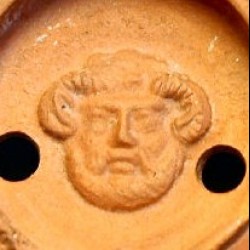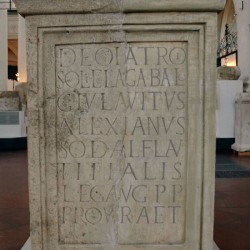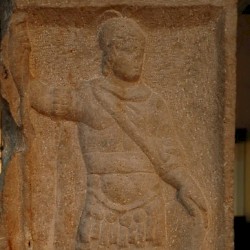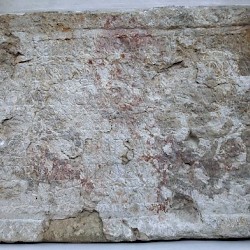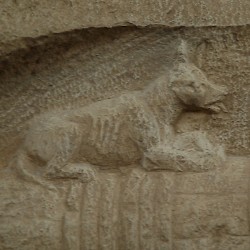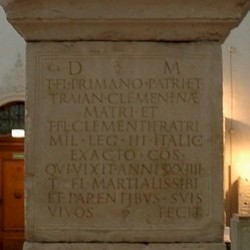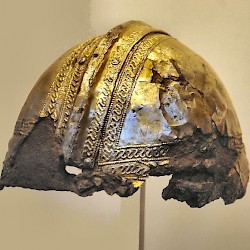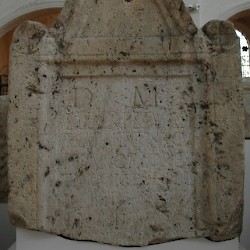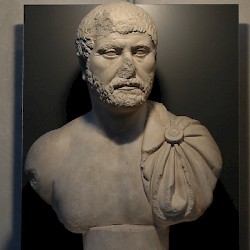Augsburg, Römisches Museum
Q2202627The Roman Museum in Augsburg is situated in the historical centre of the city, in the Church of St. Magdalena, which was originally the church of a Dominican monastery. The church was built between 1513 and 1515 and contained the funerary chapels of several important Augsburg families. Between 1716 and 1724 the church was redesigned in the baroque style. The rich decoration was mostly removed during the German secularisation 1806/07. (An important statue of Mary Magdalen from this church can nowadays be seen in the Louvre, where it is known as the “Belle Allemande”, the Beautiful German Lady.)
The church was not damaged in WW 2, and since 1966 has been the home of the Roman Museum. The exhibition starts with objects from the Stone Age and from the Urnfield Culture, which had one of its largest centres in the area of modern Augsburg. One of the side-chapels contains objects from the Hallstatt period and the La Tène Culture, with a reconstructed cart-burial chamber. Most of the exhibit, however, consists of finds from Roman Augsburg and the surrounding area, from the beginning of the Roman occupation around 15 BCE to its end in the fifth century CE.
Augsburg has Germany’s third-largest collection of Roman Provincial artefacts, although only a small portion of them can be seen in the museum. The larger part remains in the storerooms. Important exhibits are:
- The finds from Augsburg-Oberhausen, consisting of more than 10,000 mainly military objects from the time of the Roman occupation;
- A gilded Roman genius from the Early Principate;
- Military objects from a Thracian cavalry unit, which was stationed in Augsburg in the seventies;
- A famous bronze horse-head from the 2nd century;
- Several Roman tombstones from military and civilian contexts, some of them still showing the original color;
- An inscription of Claudius Paternus Clementianus, former governor of Noricum;
- Altars from a Roman sanctuary of Mercury;
- Several coin hoards from the third century;
- Architectural parts of Roman houses, like mosaics, wall paintings, floor and roof tiles;
- Domestic objects, like Roman glass vessels, ceramics, bronze items, amphorae, jewelry;
- A gilded late Roman helmet;
- An engraved glass plate depicting Adam and Eve, from around 340 CE;
- Alamannic weapons and jewelry;
- Grave inventories from the tombs of clerics from the 6th-7th century.
Recently, the church of St. Magdalena showed signs of structural distress, such as long cracks in the walls of the eastern apsis. The city has not yet responded to this alarming problem. Necessary measures would be either to build a new museum, or to close the collection for a longer period and renovate the building. Due to this problem, all special exhibitions have been postponed. Moving the Roman stones of the regular exhibit may already cause severe problems to the structural integrity of the church.
The building is only poorly suited to the needs of a modern museum. Despite its beauty, it is still a church, which means that its acoustics are very good: a problem as soon as more than one school class is in the museum. The Roman Museum is also a bit neglected in Augsburg, as the city officials tend to spend more money on the other museums and on cultural events, such as the Friedensfest-festival in 2005, or on the museums dedicated to the Medieval and Renaissance parts of Augsburg´s history. This is also visible when one passes Augsburg on the Autobahn A8, where there is a sign advertising Augsburg only as a Renaissance city.
Roman history, the reason for Augsburg’s existence, unfortunately does not play a large role in the city’s memory. This is mirrored in the Roman museum exhibit, which simply cannot afford modern equipment, as would be suited to such a fine collection. Despite all these problems, the Roman Museum is certainly worth a visit for anyone interested in Roman provincial history and archaeology.
This museum was visited in 2008.
